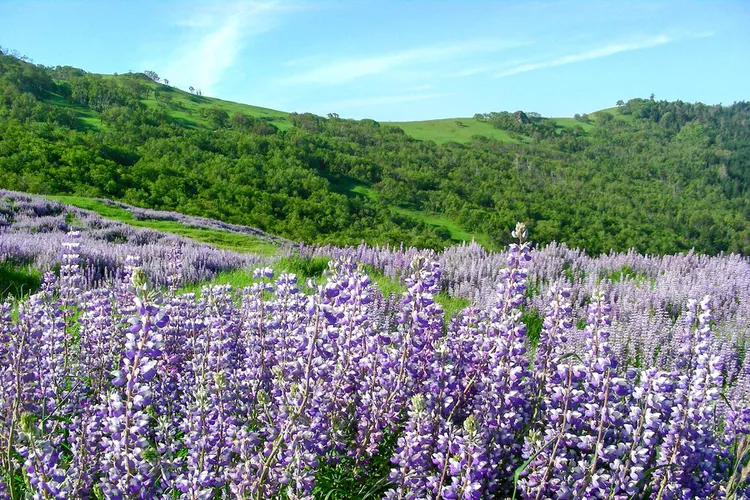Summary
National parks wow no matter the month, but there’s something particularly special about wildflower season. Pops of purple, blue, white, and gold bring magic to some of America’s most surreal landscapes. Even better, the kaleidoscopic blooms hint to warm weather on the way.
If you’re planning a trip around those spring and summer colors, bookmark these 10 best national parks to visit during wildflower season. Note that you can keep these wildflowers protected and thriving for future park visitors by following Leave No Trace guidelines, including staying on the trail.
Glacier National Park

Fields of glacier lilies and a profusion of purple asters are among the nearly 1,000 species of wildflowers that grace Glacier National Park between spring and summer. In spring, lower elevations such as Lake McDonald impress with spectacular blooms. Summer warmth brings floral hues to higher-elevation spots; the state’s beloved glacier lilies grow between 3,000 to more than 7,000 feet. Hiking trails like the Highline, Hidden Lake, and Lake McDonald showcase the colorful views.
Great Smoky Mountains National Park
There’s a reason the Smokies are on every bloom enthusiast’s wish list: with more than 1,500 flowering plants, Great Smoky Mountains National Park boasts the most flower species across all U.S. national parks. Moreover, the flowers bloom here for the majority of the year. The color profusion kicks off with ephemerals like lady slipper orchids, appearing from February through April, and then by summer, black-eyed Susans, coneflowers, and many other wildflowers take the spotlight. A soothing expanse of yellow witch hazel concludes the year from October through January. Don’t miss the park’s floral festivities at the annual Spring Wildflower Pilgrimage in late April, where wildflower trails abound in the park.
Shenandoah National Park
By spring, Shenandoah’s vibrant flora returns, showcasing over 850 plant species that create a colorful mosaic from March to August. Blooms transition from violets and large-flowered trillium to columbine, touch-me-nots, and sunflowers. Enjoy the splendor via one of Shenandoah’s wildflower vantage points, including low-elevation areas like Mill Prong and Hughes River during early spring, while the scenic Skyline Drive is best in late spring and summer.
Mount Rainier National Park

With violet blooms in the foreground and a snow-capped peak nearby, Mount Rainier National Park‘s colorful offerings are breathtaking. Admire the rich shades of magenta, gold, and blue throughout the park’s subalpine meadows in late July and August. Some of the best spots to enjoy this vibrant display include the picturesque Reflection Lakes trail and the expansive Grand Park meadow, where wildflowers flourish almost to the base of Mount Rainier.
Cuyahoga Valley National Park
The fertile soil of northeast Ohio fosters vibrant growth, with Cuyahoga Valley National Park hosting 10 operating farms. As a result, the park’s wildflowers bloom abundantly from spring to late summer, featuring species like Virginia bluebells, violets, and goldenrods. Explore paths such as the Brandywine Gorge Trail or the Kendall Lake Loop to admire these blossoming beauties.
Saguaro National Park

Poppies and desert chicory are among the many species that add vibrancy to Saguaro National Park’s desert landscape. The primary wildflower season runs from spring through early fall, with displays most vibrant after consistent rains. Even in less-than-perfect conditions, Saguaro flowers impress throughout the year, complementing the park’s iconic colossal cacti. Observe these wildflowers on trails like Bridal Wreath Falls and Valley View Overlook.
Redwood National Park
California’s majestic redwood trees are breathtaking, and a vibrant carpet of wildflowers beneath them enhances the scenery. Redwood National Park‘s wildflower blooms occur between January and September, offering colorful displays for most of the year. Spring ushers in blooms like periwinkle forget-me-nots and golden mission bells, while California poppies and western dog violets persist into late summer and fall. Notable wildflower hikes include the Trillium Falls, Lady Bird Johnson Grove, and Redwood Creek trails.
Pinnacles National Park
Pinnacles National Park features dramatic, towering rocks that are beautifully enhanced by wildflowers. In this California national park, you can enjoy wildflowers from March through May, with about 80% blooming during this period. Early blooms include bush lupine and black sage, while the hotter months bring orchids, buckwheat, and roses. Revel in these views along trails like Moses Spring Trail and Old Pinnacles Trail Loop.
Crater Lake National Park

Crater Lake National Park has a limited growing season, making blooms fleeting, roughly from July to October. However, these months alone make Crater Lake one of the premier national parks for wildflower views. The flora spans from low-elevation forests to the majestic Mount Scott stratovolcano, the park’s highest point. Witness the vibrant hues along trails like Lady of the Woods Trail, Annie Creek Canyon Trail, and Discovery Point Trail.
Death Valley National Park
Death Valley is not commonly known for frequent blooms; however, catching a wildflower display in the park is an extraordinary experience. The extreme, arid conditions necessitate near-perfect circumstances, including fall rains, for a super bloom of desert golds to adorn the valley. Rangers provide visitors with updates on the latest wildflower conditions. While the chances of experiencing a super bloom may be infrequent, the allure of waiting for such a spectacle is undoubtedly rewarding.





